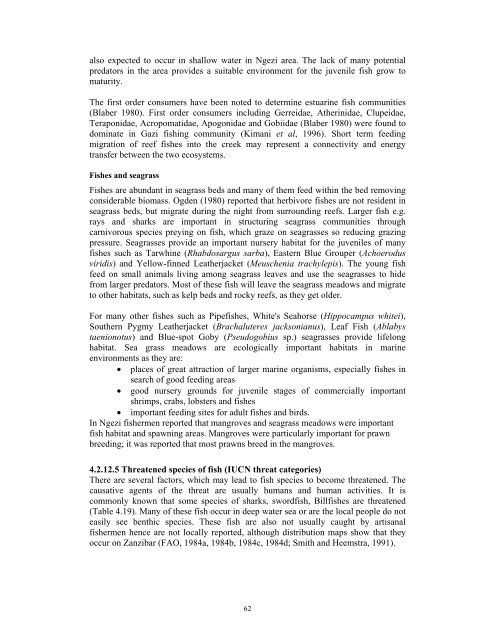serikali ya mapinduzi zanzibar care tanzania and department
serikali ya mapinduzi zanzibar care tanzania and department
serikali ya mapinduzi zanzibar care tanzania and department
Create successful ePaper yourself
Turn your PDF publications into a flip-book with our unique Google optimized e-Paper software.
also expected to occur in shallow water in Ngezi area. The lack of many potential<br />
predators in the area provides a suitable environment for the juvenile fish grow to<br />
maturity.<br />
The first order consumers have been noted to determine estuarine fish communities<br />
(Blaber 1980). First order consumers including Gerreidae, Atherinidae, Clupeidae,<br />
Teraponidae, Acropomatidae, Apogonidae <strong>and</strong> Gobiidae (Blaber 1980) were found to<br />
dominate in Gazi fishing community (Kimani et al, 1996). Short term feeding<br />
migration of reef fishes into the creek may represent a connectivity <strong>and</strong> energy<br />
transfer between the two ecosystems.<br />
Fishes <strong>and</strong> seagrass<br />
Fishes are abundant in seagrass beds <strong>and</strong> many of them feed within the bed removing<br />
considerable biomass. Ogden (1980) reported that herbivore fishes are not resident in<br />
seagrass beds, but migrate during the night from surrounding reefs. Larger fish e.g.<br />
rays <strong>and</strong> sharks are important in structuring seagrass communities through<br />
carnivorous species preying on fish, which graze on seagrasses so reducing grazing<br />
pressure. Seagrasses provide an important nursery habitat for the juveniles of many<br />
fishes such as Tarwhine (Rhabdosargus sarba), Eastern Blue Grouper (Achoerodus<br />
viridis) <strong>and</strong> Yellow-finned Leatherjacket (Meuschenia trachylepis). The young fish<br />
feed on small animals living among seagrass leaves <strong>and</strong> use the seagrasses to hide<br />
from larger predators. Most of these fish will leave the seagrass meadows <strong>and</strong> migrate<br />
to other habitats, such as kelp beds <strong>and</strong> rocky reefs, as they get older.<br />
For many other fishes such as Pipefishes, White's Seahorse (Hippocampus whitei),<br />
Southern Pygmy Leatherjacket (Brachaluteres jacksonianus), Leaf Fish (Ablabys<br />
taenionotus) <strong>and</strong> Blue-spot Goby (Pseudogobius sp.) seagrasses provide lifelong<br />
habitat. Sea grass meadows are ecologically important habitats in marine<br />
environments as they are:<br />
• places of great attraction of larger marine organisms, especially fishes in<br />
search of good feeding areas<br />
• good nursery grounds for juvenile stages of commercially important<br />
shrimps, crabs, lobsters <strong>and</strong> fishes<br />
• important feeding sites for adult fishes <strong>and</strong> birds.<br />
In Ngezi fishermen reported that mangroves <strong>and</strong> seagrass meadows were important<br />
fish habitat <strong>and</strong> spawning areas. Mangroves were particularly important for prawn<br />
breeding; it was reported that most prawns breed in the mangroves.<br />
4.2.12.5 Threatened species of fish (IUCN threat categories)<br />
There are several factors, which may lead to fish species to become threatened. The<br />
causative agents of the threat are usually humans <strong>and</strong> human activities. It is<br />
commonly known that some species of sharks, swordfish, Billfishes are threatened<br />
(Table 4.19). Many of these fish occur in deep water sea or are the local people do not<br />
easily see benthic species. These fish are also not usually caught by artisanal<br />
fishermen hence are not locally reported, although distribution maps show that they<br />
occur on Zanzibar (FAO, 1984a, 1984b, 1984c, 1984d; Smith <strong>and</strong> Heemstra, 1991).<br />
62

















